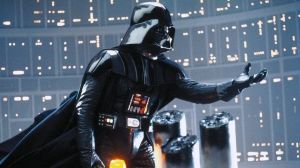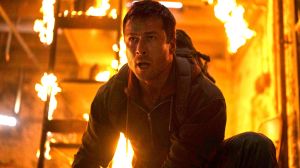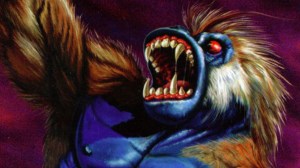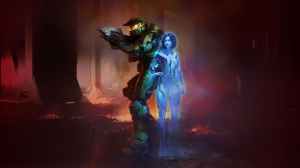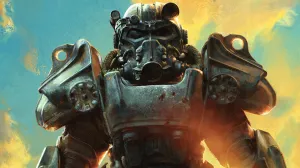
This week, Future Quest #4 expanded the universe of the Hanna-Barbera characters as they’ve existed up to this poin tin the Jeff Parker-written DC Comics series.
Videos by ComicBook.com
Introducing Frankenstein, Jr. and Mightor — and with clues as to the nature of The Impossibles in-univere — the series also made some major steps forward in the larger plot, including some big changes for Dr. Zin, the series’ villain.
Parker joined ComicBook.com to talk about the series, and the F.E.A.R. backup story that he drew in the most recent issue.
You can get a copy of Future Quest #4 at your local comic shop or on ComiXology here. Future Quest #5 by Parker and Evan “Doc” Shaner hits the stands on September 28.
Future Quest #3 was kind of an interlude; it gave us an idea of how a lot of characters got to be where they were when the story started. Is that something you want see throughout the series is giving the origins as we go rather than doing it all in one big lump and pulling people out of the story that trying to start?
I think people are interested in the origins but they wouldn’t be if I just front loaded it with here’s everybody’s origins. I think that would get old really fast. It’s just like you meet people in real life. You don’t know what they’re all about unless you Googled them when you meet somebody. You just see who they are by how they act and you start to get a sense of whether you like them or not, then you start to find that stuff out as you get in. Luckily, it’s fits our story point to un-spool the origins for different characters that way.
In this issue you get- if I’m remembering it right- you get a bit of Mightor in the beginning, and you get Frankenstein Junior. Sorry, because I’m working on issue #9 right now and I’m like, okay, now I’ve got to remember what happened in #4. Sorry about that.
To me, and this might just be my age, but it feels like you started out with almost the big three of the Justice League. Everybody recognizes Space Ghost and Birdman and Jonny Quest. Now, we’re fleshing out the world…
Definitely. Clearly, the great big linchpins are Jonny and Space Ghost. It’s kind of fun because now you bring in these others and you start to get invested in them and you realize, “Oh, wait. I didn’t think I cared about him, but now I do.”
That’s the way it works with me writing them so I assume it translates to when you’re reading them. I know it works with artists. Shaner often mentions, “I didn’t care about Birdman before, and now I’m all about Birdman.” I think you can’t help but pick up on how we get into something.
I like that you’re exploring some of the mythology of the Herculoids. Getting to know them as characters and getting to see a little bit of what happened to them, I think, gives a lot better context for why fans should care about them beyond just the cool visuals.
They were kind of bizarre because there would be so many Herculoids episodes where nothing was said. Just robots show up and the Herculoids start wailing on them. That was a fun thought experiment. “Why do the Herculoids hate robots so much?”
I just started thinking down those lines and that’s how I came up with the story and was able to work in the other planet because originally they said Amzot, and then they said they were from Quasar. I thought maybe there’s two sister planets that are going around in that solar system. I can work both of these things in.
When you’re incorporating kind of secondary and tertiary characters like Mightor and Frankenstein Junior, how do they fit into the big picture? Obviously even the characters we had seen in the first three issues hadn’t all crossed paths yet.
No. It’s tricky. At first I was drawing out this convoluted map. How did they all come into it? I was drawing it like a solar system. Frankenstein Junior is over here, the Impossibles are over here. How do you start bringing them in together? I’m not super interested in people being able to see the roadmap. I want them to just experience it. Sometimes people are like, “I can’t tell what’s going to happen.” Good because that’s how the story’s supposed to be. You’re not supposed to see all the strings and everything.
At first it was like, oh boy. I looked at that initial thing Darwyn drew with all those characters in it. How am I going to get all these together? My default systems go towards complex and I’m always having to simplify myself, but this time I about to actually, like, “Oh, I can actually run with this. I can go complex and it’s going to work because it’s an event story.”
In the next two issues you really start to probably get a sense of how it’s tying together, or at least that it is all going to be winding into one big thread very soon, which is cool because it’s fun. My first experience of doing an event story was a little smaller, it was the Flash Gordon/Mandrake/Phantom thing. This is the next vigorous step in that. I’m getting the hang of these event books.
I forgot what a big role Darwyn had in shaping the early stages of this. I really does feel like The New Frontier. Everybody has their own disparate story. You have this big bad who seems unbeatable and almost feels like a riff on Darwyn’s “The Circle.” Was that something that you looked at as model along the way, or is this just kind of a happy accident that when you take these giant worlds and you build them into one thing, that that’s the story you end up at?
New Frontier was presented to me as…Dan first approached Darwyn. I think that was the thing of it. New Frontier was to be a model for how this could all happen.
Really, even if they hadn’t said that to me, it still would’ve been just because that book looms in my reading so large. It’s still my favorite DC thing of the past forty years. You will start to see how the big creature is different from the living island that Darwyn had. It does feel the same and then once you get into it they all start to find some disturbing truths, even Doctor Zin, who’s the bad guy, starts to realize this way worse than what I was expecting. “We shouldn’t try to have this thing on our planet at all!” You know it’s bad when the bad guy starts to change his tune.
That’s actually a thing I was going to ask you about is, this seems like a classic example of the villain thinking he’s smarter than he is because it seems so self evident from the outside. It’s a terrible idea to try and open the door wider.
It is. They’re just assuming, well, we’ll just step foot in it. We’re going on old cold war stuff the way everybody was like we can harness nuclear energy, we can do this, this will be safe in our hands, these bombs and all this stuff. Doctor Zin’s the same way and then Doctor Zin starts to realize “uh-oh, we’ve made a horrible mistake.”
I love that because I don’t like – I presented him at first as the classic cold war bad guy, but then you start to realize there’s actually a lot more to him, too, and now he’s way more interesting. I want everybody to be a little off guard, like characters they don’t think they’re going to like, and then they start to grow fonder of.
Is there a balance when you’re taking these kind of characters and you’re presenting them in – they are definitely much more of their classic selves than, say, Flintstones or what Keith and Marc are doing over a Scooby-Doo Apocalypse. At the same time, you’re still adding bits. Is that a balancing act where you’re trying to keep the feel of the classic without being too constrained by it?
Yeah. The truth is, I’m never super beholden to continuity because I know which way that leads, which is to tedious stuff. To me, it’s all about having the characters in character and behaving the way you would expect or that you trust that they are.
All the details, like where they’re from and everything, we got to make up. The Space Force — this whole thing that essentially is like a big Green Lantern Corps or Rangers sort of thing that Space Ghost was originally a part of that all got wiped out. That’s just me looking at the very basics, like why did Jan and Jayce have uniforms? Why does Space Ghost had a weird version of that uniform? You start to reverse engineer something that you don’t even know if they ever came up with that because in all my reading I haven’t found anything that explains why Space Ghost does what he does from the animation years.
At the same time, also, we don’t want to nail everything down absolutely because what’s fun about it is allowing you as the reader to project a little bit of whatever you like into it. If you did nail down absolutely everything, you’d take some fun out of it. You’ve got to give it just enough so that it has mythic value.
I thought you did a really good job of striking that balance in number four because you gave the back story of how the Quasarians got there, but then when the little boy asks, “How did you come to meet the Herculoids,” it was like, “Well, bedtime now! There are some things that really should be saved for later, guys,” which I thought was a nice balance.
You can’t get everything in there. That’s when you start to realize, oh, yeah, later on if we do some self contained stuff with you guys, that’s when we’re going to want that story. We do go into a little bit of the thing that fascinated me as a kid like, what’s Igoo made of? We create the mineral Organite, this organic mineral that, say, a rock ape could come from.
That’s reminds me, though. One of the funny things is what a most valuable player Blip, this little monkey, turns out to be over and over again. When I went back and watched some of the Space Ghost cartoons I went, you know, this actually happened within a lot of them, too. He ended up being one of the most valuable characters. He’s entertaining, can steal keys.
Well, and because he’s a monkey you can just do what you want to do with him and not really worry about motivation because if it occurred to him to do it, he did it.
Yes, he’s pure id. He’s a little monkey wearing a mask, he can do whatever he wants. He’s a monkey with an inviso-belt, so he can do whatever he wants and he can turn invisible while he does it.
The thing of the series is that always leads you into being amused at some of the concepts and you’re like, oh, yeah. This is what a comic was and this is what I want out of comic books. I want to be able to think about it in that fun way and enjoy myself, like the way everybody got into Stranger Things the past few months. It’s just fun to speculate on.


